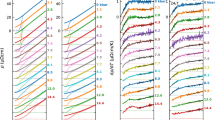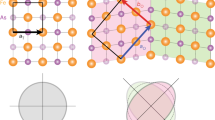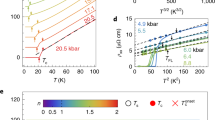Abstract
Correlated electron systems are highly susceptible to various forms of electronic order. By tuning the transition temperature towards absolute zero, striking deviations from conventional metallic (Fermi-liquid) behaviour can be realized. Evidence for electronic nematicity, a correlated electronic state with broken rotational symmetry, has been reported in a host of metallic systems1,2,3,4,5 that exhibit this so-called quantum critical behaviour. In all cases, however, the nematicity is found to be intertwined with other forms of order, such as antiferromagnetism5,6,7 or charge-density-wave order8, that might themselves be responsible for the observed behaviour. The iron chalcogenide FeSe1−xSx is unique in this respect because its nematic order appears to exist in isolation9,10,11, although until now, the impact of nematicity on the electronic ground state has been obscured by superconductivity. Here we use high magnetic fields to destroy the superconducting state in FeSe1−xSx and follow the evolution of the electrical resistivity across the nematic quantum critical point. Classic signatures of quantum criticality are revealed: an enhancement in the coefficient of the T2 resistivity (due to electron–electron scattering) on approaching the critical point and, at the critical point itself, a strictly T-linear resistivity that extends over a decade in temperature T. In addition to revealing the phenomenon of nematic quantum criticality, the observation of T-linear resistivity at a nematic critical point also raises the question of whether strong nematic fluctuations play a part in the transport properties of other ‘strange metals’, in which T-linear resistivity is observed over an extended regime in their respective phase diagrams.
This is a preview of subscription content, access via your institution
Access options
Access Nature and 54 other Nature Portfolio journals
Get Nature+, our best-value online-access subscription
$29.99 / 30 days
cancel any time
Subscribe to this journal
Receive 51 print issues and online access
$199.00 per year
only $3.90 per issue
Buy this article
- Purchase on Springer Link
- Instant access to full article PDF
Prices may be subject to local taxes which are calculated during checkout




Similar content being viewed by others
Data availability
The data that support the findings of this study are available from the authors on reasonable request. See the ‘Author Contributions’ section for specific datasets.
References
Fradkin, E., Kivelson, S.A., Lawler, M. J., Eisenstein, J. P. & Mackenzie, A. P. Nematic Fermi fluids in condensed matter physics. Annu. Rev. Condens. Matter Phys. 1, 153–178 (2010).
Borzi, R. A. et al. Formation of a nematic fluid at high fields in Sr3Ru2O7. Science 315, 214–217 (2007).
Chu, J. W. et al. In-plane resistivity anisotropy in an underdoped iron arsenide superconductor. Science 329, 824–826 (2010).
Ando, Y., Segawa, K., Komiya, S. & Lavrov, A. N. Electrical resistivity anisotropy from self-organized one dimensionality in high-temperature superconductors. Phys. Rev. Lett. 88, 137005 (2002).
Ronning, F. et al. Electronic in-plane symmetry breaking at field-tuned quantum criticality in CeRhIn5. Nature 548, 313–317 (2017).
Lester, C. et al. Field-tunable spin-density-wave phases in Sr3Ru2O7. Nat. Mater. 14, 373–378 (2015).
Nakai, Y. et al. Unconventional superconductivity and antiferromagnetic quantum critical behavior in the isovalent-doped BaFe2(As1−xPx)2. Phys. Rev. Lett. 105, 107003 (2010).
Ramshaw, B. J. et al. Quasiparticle mass enhancement approaching optimal doping in a high-T c superconductor. Science 348, 317–320 (2015).
Hosoi, S. et al. Nematic quantum critical point without magnetism in FeSe1−xSx superconductors. Proc. Natl Acad. Sci. USA 113, 8139–8143 (2016).
Baek, S.-H. et al. Orbital-driven nematicity in FeSe. Nat. Mater. 14, 210–214 (2015).
Watson, M. D. et al. Emergence of the nematic electronic state in FeSe. Phys. Rev. B 91, 155106 (2015).
Watson, M. D. et al. Suppression of orbital ordering by chemical pressure in FeSe1−xSx. Phys. Rev. B 92, 121108 (2015).
Terashima, T. et al., Anomalous Fermi surface in FeSe seen by Shubnikov–de Haas oscillation measurements. Phys. Rev. B 90, 144517 (2014).
Shibauchi, T., Carrington, A. & Matsuda, Y. A quantum critical point lying beneath the superconducting dome in iron pnictides. Annu. Rev. Condens. Matter Phys. 5, 113–135 (2014).
Cooper, R. A. et al. Anomalous criticality in the electrical resistivity of La2−xSrxCuO4. Science 323, 603–607 (2009).
Analytis, J. G. et al. Transport near a quantum critical point in BaFe2(As1−xPx)2. Nat. Phys. 10, 194–197 (2014).
Urata, T. et al. Non-Fermi liquid behavior of electrical resistivity close to the nematic critical point in Fe1−xCoxSe and FeSe1−ySy. Preprint at https://arxiv.org/abs/1608.01044 (2016).
Hussey, N. E. Non-generality of the Kadowaki–Woods ratio in correlated oxides. J. Phys. Soc. Jpn. 74, 1107–1110 (2005).
Hanaguri, T. et al. Two distinct superconducting pairing states divided by the nematic end point in FeSe1−xSx. Sci. Adv. 4, eaar6419 (2018).
Coldea, A. I. et al. Evolution of the Fermi surface of the nematic superconductors FeSe1−xSx. npj Quant. Mater. 4, 2 (2019).
Pal, H. K. et al. Resistivity of non-Galilean-invariant Fermi- and non-Fermi liquids. Lith. J. Phys. 52, 142–164 (2012).
Bendele, M. et al. Pressure induced static magnetic order in superconducting FeSe1−x. Phys. Rev. Lett. 104, 087003 (2010).
Wiecki, P. et al. NMR evidence for static local nematicity and its cooperative interplay with low-energy magnetic fluctuations in FeSe under pressure. Phys. Rev. B 96, 180502 (2017).
Grinenko, V. et al. Close proximity of FeSe to a magnetic quantum critical point as revealed by high-resolution μSR measurements. Phys. Rev. B 97, 201102 (2018).
Matsuura, K. et al. Maximizing T c by tuning nematicity and magnetism in FeSe1−xSx superconductors. Nat. Commun. 8, 1143 (2017).
Maslov, D. L., Yudson, V. I. & Chubukov, A. V. Resistivity of a non-Galilean–invariant Fermi liquid near Pomeranchuk quantum criticality. Phys. Rev. Lett. 106, 106403 (2011).
Maslov, D. L. & Chubukov, A. V. Fermi liquid near Pomeranchuk quantum criticality. Phys. Rev. B 81, 045110 (2010).
Hartnoll, S. A., Mahajan, R., Punk, M. & Sachdev, S. Transport near the Ising-nematic quantum critical point of metals in two dimensions. Phys. Rev. B 89, 155130 (2014).
Lederer, S., Schattner, Y., Berg, E. & Kivelson, A. Superconductivity and non-Fermi liquid behavior near a nematic quantum critical point. Proc. Natl Acad. Sci. USA 114, 4905–4910 (2017).
Yu, R. & Si Q. Antiferroquadrupolar and Ising-nematic orders of a frustrated bilinear-biquadratic Heisenberg model and implications for the magnetism of FeSe. Phys. Rev. Lett. 115, 116401 (2015).
Bruin, J. A. N., Sakai, H., Perry, R. S. & Mackenzie, A. P. Similarity of scattering rates in metals showing T-linear resistivity. Science 339, 804–807 (2013).
Audouard, A. et al. Quantum oscillations and upper critical magnetic field of the iron-base superconductor FeSe. Europhys. Lett. 109, 27003 (2015).
Lin, J.-Y. et al. Coexistence of isotropic and extended s-wave order parameters in FeSe as revealed by low-temperature specific heat. Phys. Rev. B 84, 220507 (2011).
Bӧhmer, A. et al. Origin of the tetragonal-to-orthorhombic phase transition in FeSe: a combined thermodynamic and NMR study of nematicity. Phys. Rev. Lett. 114, 027001 (2015).
Hardy, F. et al. Nodal gaps in the nematic superconductor FeSe from heat capacity. Preprint at https://arxiv.org/abs/1807.07907 (2018).
Huynh, K. K. et al. Electric transport of a single-crystal iron chalcogenide FeSe superconductor: evidence of symmetry-breakdown nematicity and additional ultrafast Dirac cone-like carriers. Phys. Rev. B 90, 144516 (2014).
Watson, M. D. et al. Dichotomy between the hole and electron behavior in multiband superconductor FeSe probed by ultrahigh magnetic fields. Phys. Rev. Lett. 115, 027006 (2015).
Acknowledgements
We acknowledge discussions with Q. Si, A. Chubukov and J. Schmalian. We also acknowledge the support of the HFML-RU/NWO, a member of the European Magnetic Field Laboratory (EMFL). This work is part of the research programme ‘Strange Metals’ (grant number 16METL01) of the former Foundation for Fundamental Research on Matter (FOM), which is financially supported by the Netherlands Organisation for Scientific Research (NWO). A portion of this work was also supported by the Engineering and Physical Sciences Research Council (grant number EP/L015544/1), by Grants-in-Aid for Scientific Research (KAKENHI) (grant numbers 15H02106, 15H03688, 15KK0160, 18H01177 and 18H05227) and Innovative Areas ‘Topological Material Science’ (grant number 15H05852) from the Japan Society for the Promotion of Science (JSPS).
Reviewer information
Nature thanks E.-A. Kim and the other anonymous reviewer(s) for their contribution to the peer review of this work.
Author information
Authors and Affiliations
Contributions
N.E.H. initiated the project (in collaboration with Y.M. and T.S.). S.K. synthesized the FeSe1−xSx single crystals. S.L., J.B., J.A. and J.L. performed the magnetotransport measurements. S.L. and N.E.H. analysed the data. N.E.H. and S.L. wrote the manuscript with input from all co-authors.
Corresponding author
Ethics declarations
Competing interests
The authors declare no competing interests.
Additional information
Publisher’s note: Springer Nature remains neutral with regard to jurisdictional claims in published maps and institutional affiliations.
Extended data figures and tables
Extended Data Fig. 1 Calibration of the Cernox temperature sensor in a magnetic field of 35 T between 0.3 K and 30 K.
The coloured symbols in the graph are the data points taken at different constant temperatures as explained in the text. The points were then divided into four temperature intervals to calculate phenomenological fits, plotted here as lines. The inset shows a detail of the lowest temperature range.
Extended Data Fig. 2 Low-temperature magnetoresistance of FeSe1−xSx.
a, Field sweeps obtained for a sample with x = 0.2 at several fixed temperatures. The magnetoresistance itself has a negligible temperature dependence over the entire temperature range studied. b, Comparison of a selection of field sweeps for x = 0. Note that the extent of the y scale is different for the 1 K curve because ρab is much smaller than at higher temperatures.
Extended Data Fig. 3 Field derivative of the magnetoresistance between 34 T and 35 T at different temperatures for x = 0.13.
The blue symbols represent the slope of linear fits to the magnetoresistance (dρab/dB) curves, while the pink symbols are the difference between the 35 T resistivity and its extrapolated value at zero field. Down to about 1.5 K, the magnitude of the magnetoresistance (MR) is essentially constant. Below 1.5 K, the effect of superconducting (SC) fluctuations on the magnetoresistance can be clearly seen. Vertical error bars represent a compound error of the difference in slope maxima and mimina associated with the scatter in the data and uncertainty in the geometrical factors.
Extended Data Fig. 4 Temperature dependence of the in-plane resistivity ρab of FeSe1−xSx.
The plots show ρab(T) curves in zero field and in a 35 T magnetic field B//ab, for all x.
Extended Data Fig. 5 Definition of the temperature scales T1 and T2.
For each x value, the temperature derivative of the resistivity curve was obtained after binning and smoothing the 35 T data of Extended Data Fig. 4. The extent of the T-linear behaviour of dρab/dT defines T2, whereas the onset temperature of the constant regime is T1.
Extended Data Fig. 6 Determination of the A coefficients from the resistivity curves.
Raw data plotted against T2.
Extended Data Fig. 7 Determination of the A coefficients from the resistivity curves.
Binned and smoothed data plotted against T2.
Extended Data Fig. 8 Determination of Ts.
The structural phase-transition temperature Ts is determined from the temperature derivatives of the resistivity curves in a broad temperature range of up to about 150 K. The kink in the resistivity curves that can be seen in Fig. 1c corresponds to a dip in the derivatives.
Extended Data Fig. 9 The x-dependence of the quantum oscillation frequencies F in FeSe1−xSx.
The black circles and terracotta diamonds represent respectively the evolution, as a function of S substitution x, of the sums α+δ and β+γ of the quantum oscillation frequencies reported in ref. 21. The two dashed lines are linear fits that were used in the determination of kF (at each x) for the renormalization of the A coefficient (to A*) and in the estimate of α, the prefactor in the strength of the T-linear scattering rate. See Methods for more details.
Extended Data Fig. 10 Determination of Hc2.
a, Definition of Hc2 at T = 1.35 K for x = 0.25. b, Plotted values of Hc2(T = 1.35 K) as a function of varying x. The black dashed lines are exponential fits. Hc2(T = 1.35 K, x = 0) is much smaller than at higher S concentrations, presumably owing to the lower level of disorder in FeSe. Vertical error bars originate from uncertainties in the determination of Hc2 (as defined in Methods) due to scatter in the raw field sweeps. The larger error bar for x = 0.16 is due to the additional uncertainty caused by having to extrapolate the Hc2 curve below 4.2 K.
Extended Data Fig. 11 T-linear resistivity at x ≈ xc.
Estimation of lower limit of A for x = 0.16 from the temperature derivative of the 35 T resistivity curve. The slope of the blue dashed line is 2A = 0.66 μΩ cm K−2. The arrow indicates the temperature at which ρab(T) ceases to be strictly linear. As shown in Fig. 4b, T2 (the temperature below which the T2 resistivity first appears) is approximately half that of T1 (the temperature down to which the resistivity remains T-linear) for all x < 0.16. Thus, it is not unreasonable to assume that the maximum value of T2 for xc = 0.16, if indeed the resistivity does cross over to T2, is a factor of two smaller than the base temperature of our experiment, making our estimate for the minimum value of A twice the absolute minimum plotted in Fig. 3b.
Source data
Rights and permissions
About this article
Cite this article
Licciardello, S., Buhot, J., Lu, J. et al. Electrical resistivity across a nematic quantum critical point. Nature 567, 213–217 (2019). https://doi.org/10.1038/s41586-019-0923-y
Received:
Accepted:
Published:
Issue Date:
DOI: https://doi.org/10.1038/s41586-019-0923-y
This article is cited by
-
Nanoscale inhomogeneity and the evolution of correlation strength in FeSe\(_{1-x}\)S\(_x\)
Nano Convergence (2023)
-
Expanded quantum vortex liquid regimes in the electron nematic superconductors FeSe1−xSx and FeSe1−xTex
Nature Communications (2023)
-
The scaled-invariant Planckian metal and quantum criticality in Ce1−xNdxCoIn5
Nature Communications (2023)
-
Interplay between superconductivity and the strange-metal state in FeSe
Nature Physics (2023)
-
Unusual crossover from Bardeen-Cooper-Schrieffer to Bose-Einstein-condensate superconductivity in iron chalcogenides
Communications Physics (2023)
Comments
By submitting a comment you agree to abide by our Terms and Community Guidelines. If you find something abusive or that does not comply with our terms or guidelines please flag it as inappropriate.



